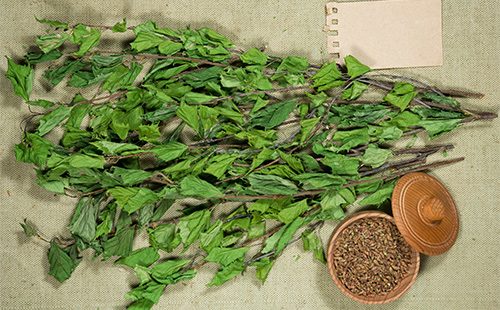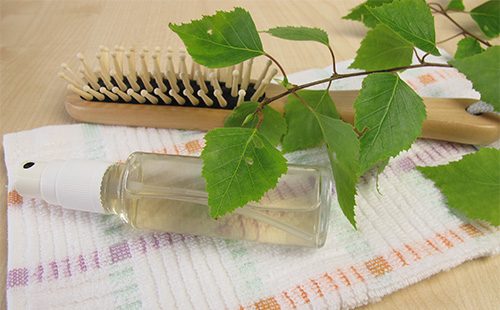The content of the article
Small leaflets of a triangular-ovoid shape are characteristic of a drooping (warty) and fluffy plant species. In swamp and dwarf trees, they are round in shape. The edges are always carved. The surface is smooth, with well-developed veins. Length up to 7 cm, width - up to 4 cm. Absolutely symmetrical, often planting old branches and young shoots, they form luxurious crowns, for the decorativeness of which the plant has long been valued in Russia.
Pharmacological features of raw materials
Birch can be accurately distinguished not only by the characteristic appearance of the trunk, but also by the stickiness of young leaves when they bloom. The surface is covered with a sticky substance, disappearing only when the crown is fully opened. It is too early to harvest raw materials during this period, since medicinal substances only accumulate. It gains maximum benefit when the stickiness goes away completely.
Collection and Harvesting
Raw materials are harvested in different regions of Russia at different times. In the southern regions, this can be done already in May (only culture is rare here, preferring a cooler climate). In the north - the collection time falls on June-July.
Collect medicinal raw materials in baskets or fabric bags. Tearing greens indiscriminately, both from old and young trees. By the way, useful properties are characteristic for the leaves of all plant species. Phytotherapist N. Maznev notes that in different climatic zones, the crown of birch species can be used with equal efficiency:
- drooping (warty);
- fluffy;
- flat-leafed (Manchurian);
- dwarf (yernik).
Use raw materials fresh or dried. Before drying, it is recommended to grind it immediately, since then the plates become brittle, crumble, quickly turn into powder and give too much dust. Dry the mass on clean litter in the shade or in a well-ventilated area, sprinkling with a thin layer.
Composition and properties
Groups of biologically active substances are identified in the composition of raw materials:
- organic acids;
- tannins (up to 9%);
- flavonoids (up to 3%);
- saponins (up to 4%);
- coumarins;
- Sahara.
Vitamin C is high in plant raw materials, its concentration reaches 8%. But during drying, ascorbic acid decomposes, its residual volume in the dried mass is only 17% of the original.
The latest studies have identified a group of lipids, including linoleic, linolenic and oleic acids. As well as vitamins A and P in high concentration. “The content of A and P vitamins in the vegetative organs of the plant reaches high values - 200 mg / kg,” say experts of Altai State Technical University A. Savenko and A.Shrike in the work “Physicochemical Properties and Thermophysical Characteristics of Hanging Birch Leaf Extracts”. “For comparison, the content of these vitamins is twice that of conifers.”
The concentrated composition gives the raw material six pharmacological properties.
- Antioxidant. Reduces the intensity of oxidation reactions in tissues and substances. Raw materials are useful for diseases accompanied by inflammation, as it reduces the production of free radicals, protects tissues from damage due to oxidative stress.
- Antimicrobial. The broad antimicrobial effect of drugs from birch leaves has been experimentally established. Russian experts A. Savenko and A. Sorokopud note their ability to inhibit the growth of bacterial and fungal microflora. Phytotherapist N. Maznev points out that pathogenic microbes and parasites die within two to three hours after taking the medicine. This allows the use of raw materials in the treatment of giardia and other parasitic lesions of the body.
- Decongestant. Drugs have diuretic and diaphoretic effects. The latter is useful for colds, viral diseases. In addition, due to the high content of vitamin C, the raw material supports the immune system and stimulates the production of antibodies. The diuretic effect is especially valuable for patients suffering from edema on the background of heart failure.
- Anti-inflammatory. It appears with jade, nephrosis. A decoction of the leaves significantly reduces the protein content in the urine against the background of the inflammatory process, which allows us to talk about its healing effect on the urinary system.
- Vitaminizing. High concentrations of vitamins A, P, C allow you to use the drug for vitamin deficiency, for the overall strengthening of the body. A. Turova describes the practice of using the infusion as a general strengthening agent for long-healing wounds of soldiers during the Second World War. N. Maznev notes the effectiveness of the agent for the treatment of scurvy caused by an acute deficiency of ascorbic acid.
- Painkiller. Raw materials in folk medicine are used as a painkiller for rheumatic, neuralgic pains of joints, limbs.
Not confirmed by science, but herbalists noted the ability of the herbal preparation to normalize the hormonal background in women, which improves the condition in the menopause. The composition stimulates metabolic processes, provides the outflow of excess fluid from the body, which indirectly contributes to weight loss and is useful in the fight against cellulite.
It is believed that the use of photographic aids promotes the dissolution of uric acid crystals in tissues and joints, and facilitates the condition of patients with gout.

Contraindications
Universal herbal remedy has virtually no contraindications. But it is not recommended to use it with:
- pregnancy
- the presence of stones in the gall bladder and kidneys;
- chronic renal failure;
- acute glomerulonephritis.
Pregnancy is considered a conditional contraindication. The instruction for the use of birch leaves, certified by the Ministry of Health of Russia, does not prohibit the inclusion of a herbal preparation in the treatment of expectant and lactating mothers. But only as prescribed by the doctor and with the wording: "when the potential risk to the fetus and child is lower than the expected benefit to the mother." This is due to the lack of research on the effect of raw materials on women in position and fetus. There are no data confirming or refuting the teratogenic effect.
Prescription Drugs
For preparation of medicines use a fresh or dried leaf.The benefit of the first is higher due to the content of vitamin C, which is destroyed when dried. When choosing dry raw materials in a pharmacy, pay attention to large integral parts. Do not buy the product in powder, as there are no valuable substances in the dust.
Fresh water infusion
Features. Recommended for colds and viral diseases, cardiac edema, with a lack of vitamin C. The drug is active against parasites that live in the intestines (giardia, worms). Normalizes metabolic processes. In the resulting infusion, a thick precipitate is noticeable, which gives the drug a bitter taste. It can be removed using a charcoal or fabric filter, but filtration reduces the content of biologically active substances.
How to make and use
- Finely chop 50 g of raw material.
- Pour in cold purified water, rinse, drain the water.
- Fill with water at a temperature of 40-50aboutWith a volume of 500 ml.
- Leave to brew for three and a half hours.
- Drain, squeeze the sheet mass.
- Leave to brew for another six hours.
- Take the drug in half a glass two to three times a day.
Water infusion from dried raw materials
Features. A remedy for the treatment of kidney disease, excretion of uric acid from the body. The residual content of vitamin C allows its use in spring vitamin deficiency. They recommend the drug for damage to the skin and tissues - it increases the immunity to pathogenic microorganisms, accelerates the healing of wounds and burns. The amount of raw materials for the preparation of funds should be determined individually. A tablespoon is enough for a child, two for an adult with an average weight. If the patient weighs more than 80 kg, use three tablespoons.
How to make and use
- Pour one to three tablespoons of dried raw material into the container.
- Pour in 500 ml of warm water.
- Leave to brew for three hours.
- Squeeze out the swollen mass.
- Leave to brew for another six hours.
- Take the drug two to three times a day before meals. The minimum dosage is 50-100 ml, the maximum is 200 ml.
Infusion of alcohol
Features. It is recommended for heart diseases, accompanied by swelling of the limbs, tissues. With bedsores, burns, joint pain, tincture is applied externally in the form of compresses on the affected area.
How to make and use
- Grind a fresh leaf.
- Pour two tablespoons of raw material into the container.
- Pour alcohol with a strength of 70about 200 ml.
- Leave to brew for seven days.
- Strain.
- Take 30-40 drops three times a day before meals.
Decoction
Features. During boiling, vitamin C is completely destroyed, so the product does not have general strengthening properties. However, its choleretic effect is most pronounced, which allows recommending the composition to people suffering from biliary dyskinesia to increase the volume of bile production.
How to make and use
- Pour two tablespoons of chopped fresh or dried raw material into an enameled container.
- Pour boiling water with a volume of 500 ml.
- Bake for ten minutes under a lid over low heat.
- Leave to infuse for 30 minutes.
- Strain.
- Take a decoction of 50 ml with food three times a day.

Hair conditioner
Features. Raw materials are used in cosmetology to strengthen hair and fight dandruff. The tannins included in the composition dry the scalp, reduce fat content, and help eliminate seborrhea. To isolate them, heat treatment is required. The broth should be concentrated, and the composition of fresh raw materials will bring the greatest benefit.
How to make and use
- Grind fresh raw materials.
- Pour six tablespoons into an enameled container.
- Pour boiling water with a volume of 500 ml.
- Boil over low heat for 15 minutes.
- Cool.
- Strain.
- Use a hair rinse twice daily in the morning and evening. At the same time, you should not wash your hair with shampoo every time.
Dry birch leaf is stored for six months, while the monthly concentration of vitamins in it is reduced. To prepare an infusion of dried raw materials, use a phytopreparation prepared in the summer. Next year, update stocks of herbal remedies.

